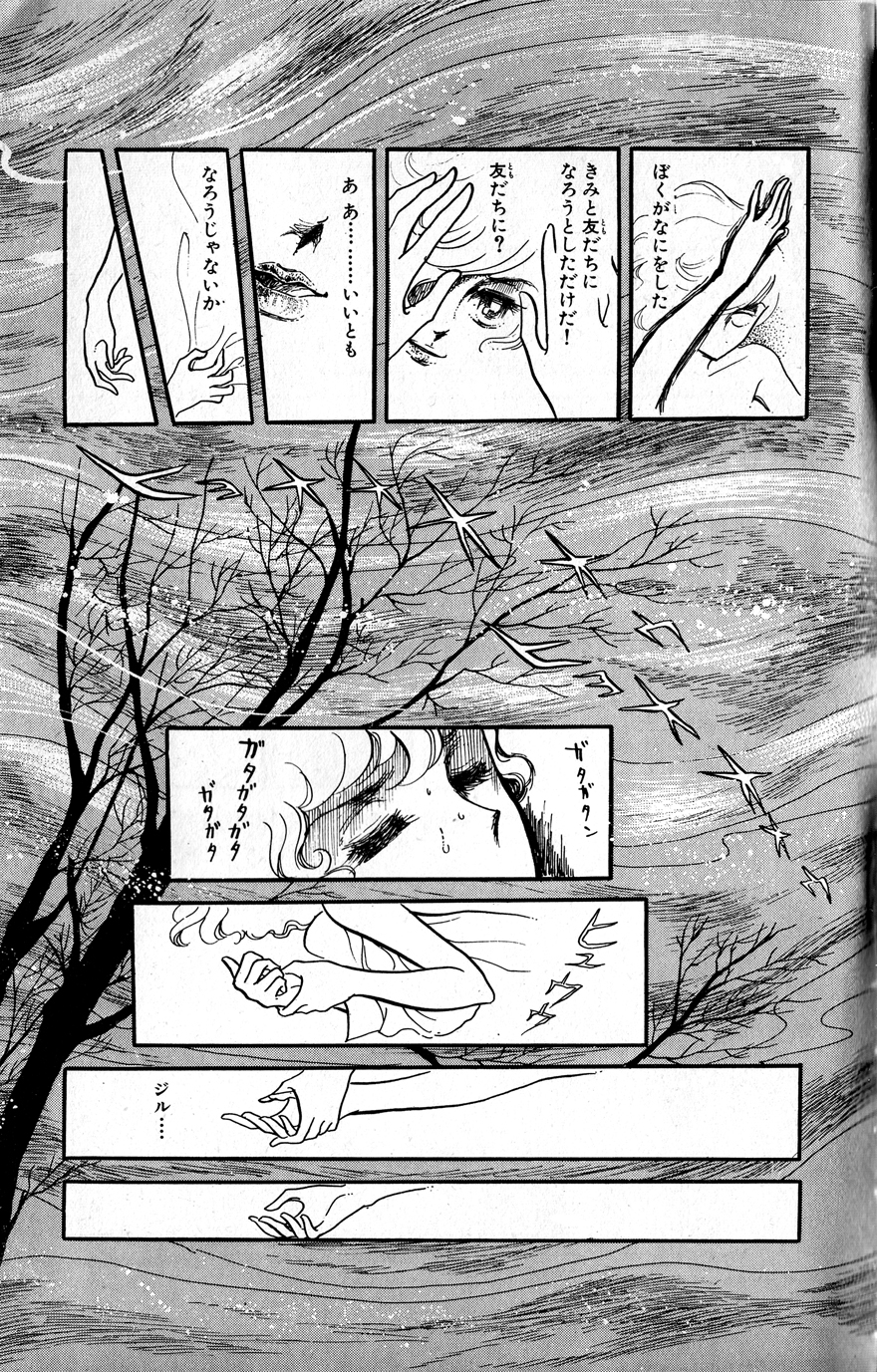From Comics: A Global History, 1968 to the Present. Â Chapter 5: Shojo Manga in the Seventies
How rapidly did shojo manga “mature†in the late 1960s and early 1970s? In 1965, Mary Lou by Yoshiko Nishitani was considered the first shojo manga to portray the romantic concerns of average, contemporary Japanese teenage girls: boyfriends, dating, going to the prom, etc.  By 1969, Hideko Mizuno’s Fire featured actual, if non-explicit, sex scenes; in 1970, Yumiko Oshima published Tanjou (Birth), a story about an unwed, pregnant teenage girl dealing with the question of abortion; the following year, 1971, Moto Hagio’s November Gymnasium and Ryoko Yamagishi’s Couple in the White Room portrayed homosexuality (male and female, respectively) among teenagers at boarding schools.
Formally as well, some of the most significant and exciting innovations in Japanese comics in the 1970s took place in the realm of shojo manga. The female readership was maturing, creating possibilities and demands for more challenging material. But there was another factor: the entry into the field of a large number of female mangakas. This was the generation known as the hana no nijuuyo nen gumi: the “magnificent 24 gang,†or, more simply, the Year 24 group (most of these artists were born around the Year 24 of Showa era in the Japanese calendar, which corresponds to 1949). These women were not much older than their readers, and a vital and vibrant new sensibility soon manifested in their work.
A Brief History of Shojo Manga Prior to 1970
In the pre–World War II period, when most Japanese comics were aimed at very young readers, the main vehicles for popular culture designed for adolescent girls were shojo literary magazines and novels. This material reinforced prevailing notions of proper feminine roles and characteristics in Japanese society, which was extremely restrictive. Heterosexual romance was rarely depicted; the literature focused primarily on the all-female world of girls’ schools, and on female friendships, often in a dreamy and flowery literary style (the term shojo carries connotations of cloistered maidenhood, not captured by the usual translation as “girlâ€). The style of illustration that accompanied these stories, known as jojo-ga, “lyrical drawing,†matched the tone of the prose.
After the war, shojo manga began to emerge. Much of it followed the example of Tezuka’s Ribon No Kishi (Princess Knight) (1953) an entertaining, action-packed fantasy for girls. Fairy tale–flavored adventures such as Leiji Matsumoto’s Green Angel (1960) or 1958’s Silver Petals by Hideko Mizuno offered exotic fantasies in faraway lands, while melodramas like Tetsuya Chiba’s Mama’s Violin or Miyako Maki’s Maki’s Whistle were sentimental dramas in which the primary relationship was usually mother-daughter. Romance was rare; tales of orphans and princesses abounded, and the jojo-ga visual ideal of femininity—dreamy, melancholy maidens with large, liquid eyes, surrounded by decorative floral patterning—was carried on by artists like Macoto Takahashi, whose gently paced stories, like Sakura Namiki (The Rows of Cherry Trees) (1957), which revived the girls’ school friendship drama, focused more on emotion and beauty than plot or action.
Â
During the 1950s and early sixties, most shojo artists were men, but there were several important female mangaka—Hideko Mizuno, Masako Watanabe, Miyako Maki, Yoshiko Nishitani and Chieko Hosokawa the most prominent. —As publishers sought to reach the maturing female audience, they turned increasingly to women creators.
Evidence of a new energy and ideas in the shojo arena are seen in Mizuno’s ground-breaking Fire, serialized in Monthly Seventeen (1969–1971). Fire is credited as the first shojo manga to feature a male protagonist, and the first to include sex scenes. An epic tale following the rise and fall of a young American rock ‘n roller, it dealt with heavy themes of sex, drugs, racial prejudice and the Vietnam War. Mizuno sought to escape the limits of shojo classification altogether: inspired by gekiga, she moved away from the cute, rounded, Tezukian style of her earlier work, to a more angular – though still highly romanticized – graphic approach. The result, surprising even Mizuno , was that the series soon began attracting a sizeable male readership, despite being printed in a shojo magazine.
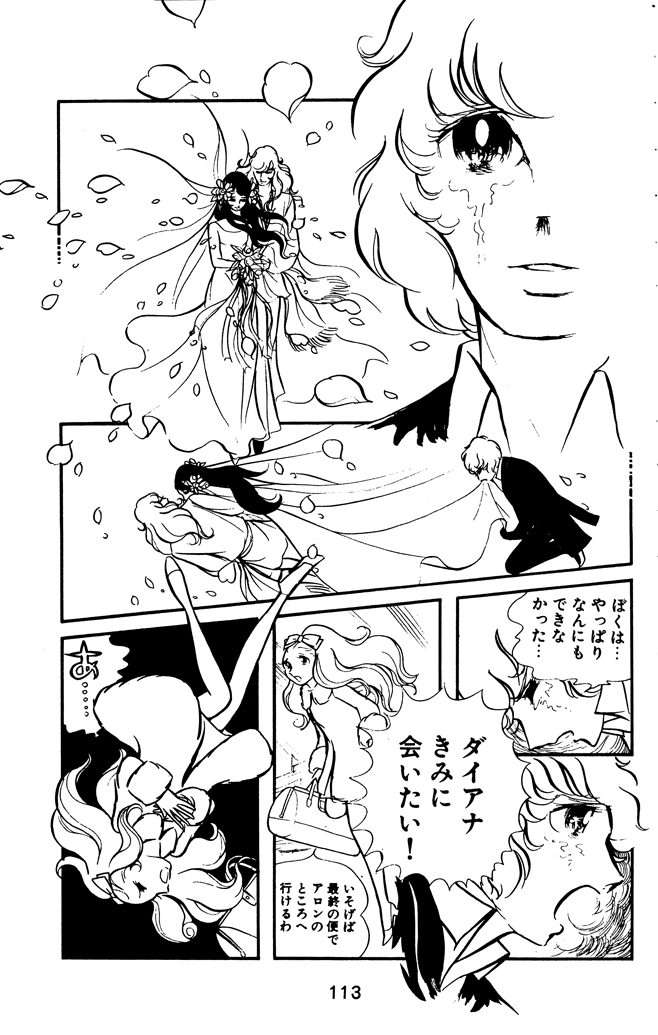
Mizuno’s narrative and formal innovations were as important as the daring content; many pages displayed radically new approaches to layout and visual narrative, breaking from the “cinematic†style of comics story-telling prized by Tezuka and the gekiga artists. In the cinematic model, each panel approximates a film frame, with a defined “camera angleâ€; panel relationships are defined in terms of spatial relationships, physical action and temporal sequence. Many pages in Fire, by contrast, employ an open or layered visual structure: the images are not taking place strictly on the lens of the artist’s “camera,†but on an emotional plane, generated by the feelings of the characters (Fig. 6.02). At emotional peaks in the story, Mizuno dispenses with the convention of panel borders in part or altogether, creating a sense of simultaneity as opposed to temporal sequence. (Fig. 6.03)
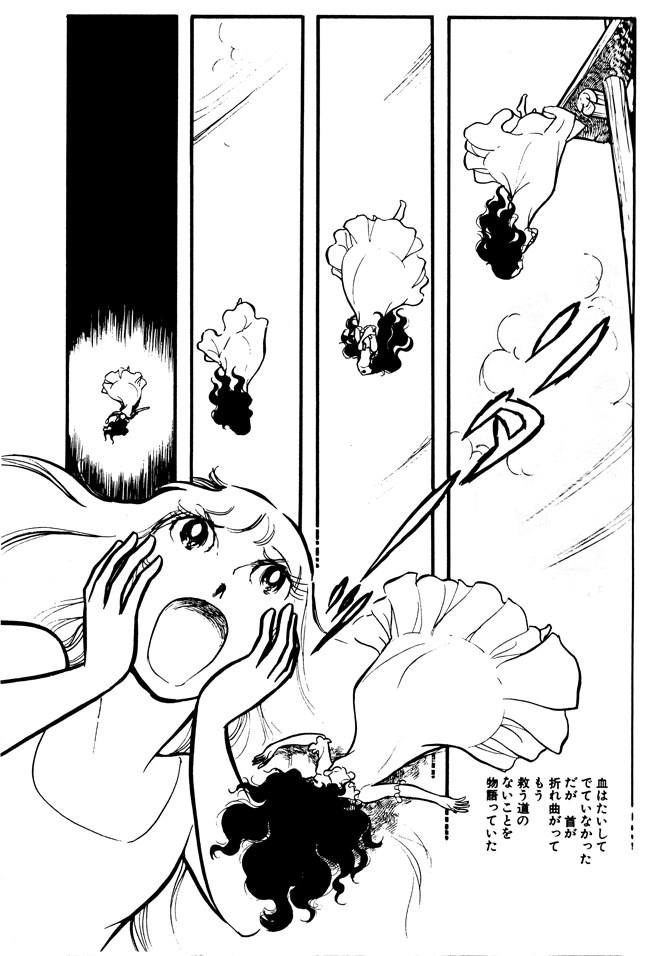
These new techniques can be seen as a dramatic evolution from traditional shojo manga devices: since the 1950s, shojo artists had, in limited ways, experimented with escaping the temporal grid, using superimposed images to illustrate thoughts and memories, as well as “style pictures†(sutairu ga)—full-length depictions of a character along one side of the page that showed off costume designs, but additionally suggested a character’s existence outside of the frame-to-frame flow of the narrative (fig 06.08) 21 Mizuno’s innovations went much further,  making bold formal statements that would become essential parts of the vocabulary of the next generation of manga artists.
Meanwhile, a generation of young female mangaka had been paying their dues in the industry, starting as teenagers in the mid-sixties. By 1970, major works from this new generation began to appear. In many ways, the “Year 24 revolution†looked backward as well as ahead, imbuing the traditional narrative structures and genre conventions of shojo narrative with a strikingly modern sensibility, especially in their explorations of issues of gender identity and sexuality. Following Mizuno’s lead, radical new approaches to page layout organized the space of the page and the inter-relationship of images (in other words, the essential components of comics story-telling) around emotional principles as well as around action, time and space. That the Magnificent 24er’s accomplishments were achieved within a mainstream commercial context makes them all the more impressive.
The first major success of the Year 24 generation was Riyoko Ikeda’s phenomenally popular Versailles No Bara (Rose of Versailles), a sweeping historical romance set in the French Revolution, which was serialized in the magazine Margaret in 1972 and 1973. Ikeda, then twenty-four years old, had become fascinated with the character of Marie Antoinette during college. Having convinced Margaret’s skeptical editors that historical drama would interest their young teen readers, Ikeda began her epic in traditional shojo form: eleven-year old Marie is a “poor little rich girl,“ an Austrian princess married off as a child to the uncharismatic dauphin, swept away from home and mother to a foreign royal court full of intrigue and treachery. Reader reaction vindicated Ikeda’s instincts, and the series sparked a nationwide craze for the Court of Versailles. As Ikeda developed the story, however, it became clear that readers were less interested in Marie than another character: the fictional Oscar De Jarjaynes. (Fig. 6.04) Oscar is a woman, raised and dressed as a male, who becomes the head of the palace guard; initially Marie’s most loyal defender, she comes to sympathize with the peasants and switches sides over the course of the story.

Cross-dressing heroines were not a new phenomenon in shojo manga, going at least as far back as Osamu Tezuka’s 1953 series Ribon No Kishi. But with Oscar, Ikeda created a new and more ambiguous gender role model; while heterosexual, she effortlessly embraces masculine qualities of independence and physical courage, and finds romance with a fellow soldier who accepts her, not only as an equal, but as a superior.
In her visual technique, Ikeda builds on the emotion-driven page layouts seen in Fire: Permeable, overlapping panels reinforce multiple characters’ points-of-view and the borders between images become as fluid as the uncertain distinctions of gender.
Ikeda continued experimenting with page layouts of visual and emotional complexity in subsequent work, such as Oniisama E (Dear Brother) (1975). (Fig. 6.05) Set in a contemporary all-women’s college, Oniisama E harkens back to the girls’ school dramas of pre-war shojo literature, or The Rows of Cherry Trees. The story focuses on Nanako, an innocent, naïve freshman who finds herself implicated and manipulated in the interpersonal machinations of a group of sophisticated older students. Unlike many earlier shojo treatments of the subject matter, Ikeda incorporates real-life concerns such as drug addiction and suicide. In Oniisma E, moreover, same-sex romantic longings are explicitly acknowledged, if not consummated, making it one of the earliest examples (along with Ryoko Yamagishi’s 1971 Shiroi Heya No Futari [HS1] ) of the yuri sub-genre, which focuses on lesbian relationships and eroticism.
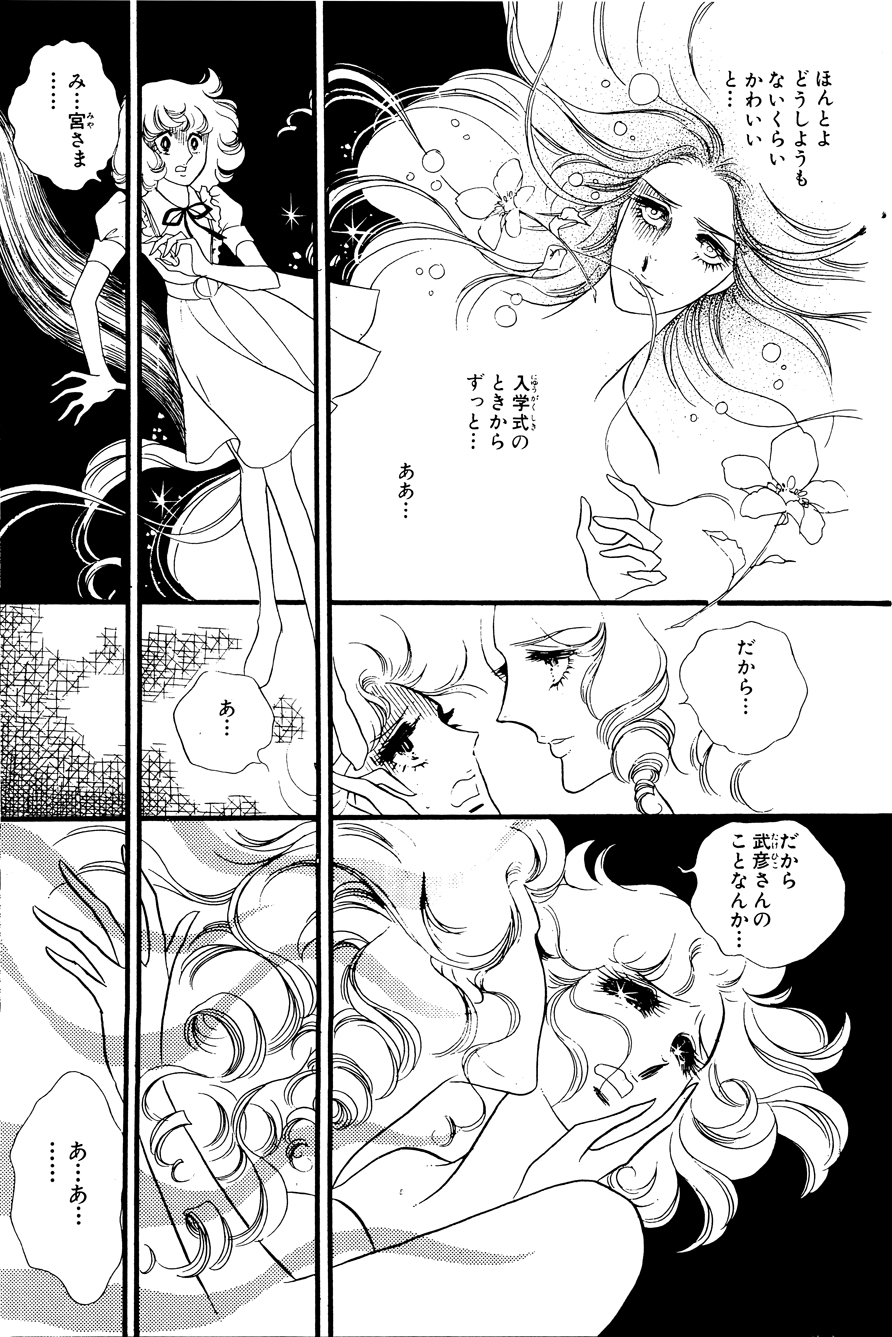
The theme of same-sex romance in school settings was continued in the work of two other members of the Year 24 generation: Moto Hagio’s Thomas No Shinzou (The Heart of Thomas 1974) and Keiko Takemiya’s Kaze To Ki No Uta  (Song of Wind and Trees) (1976), though here the amorous young scholars are boys.
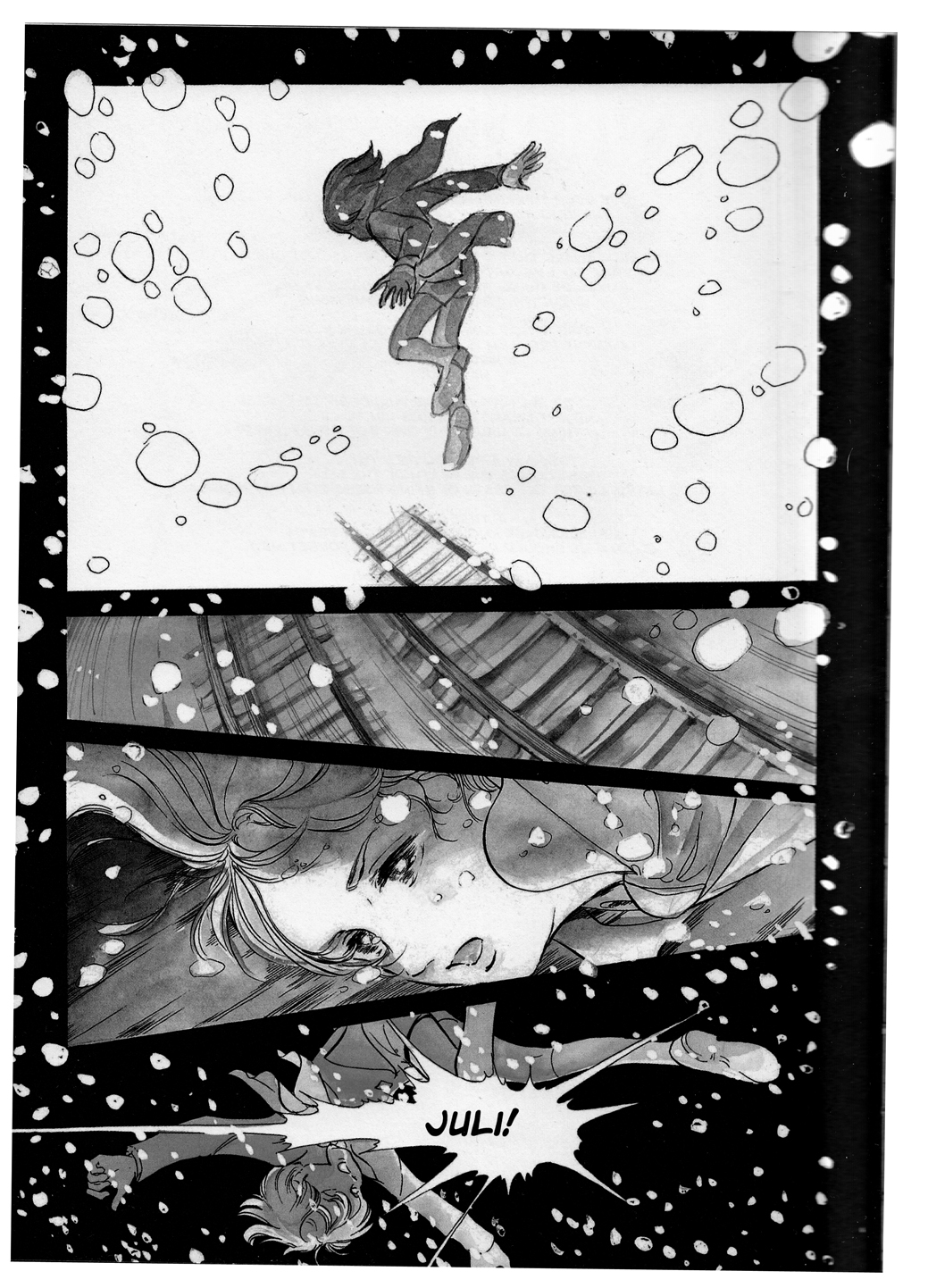
In the early seventies Hagio and Takemiya were roommates in an apartment in the Oizumi neighborhood of Tokyo. Other young female artists lived or gathered there as well, creating a sort of “salon†for young shojo mangaka. Hagio initially had trouble finding acceptance among publishers because of the slow and reflective tone of her work. Junya Yamamoto, editor of Shogokukan’s new Shojo Comic, appreciated the unusual qualities in the young Hagio’s manga, and printed several of her stories that had been rejected by other publishers. Hagio’s first major series, the gothic Poe No Ichizoku (The Poe Clan). Ahead of its time, it was the first major work to treat the otherness of the vampire from a romantic, existential perspective.
Hagio’s Heart of Thomas (and its shorter precursor, November Gymnasium) preceded Song of Wind and Trees, but the projects seem to have gestated more or less simultaneously, inspired by a 1964 French film that Takemiya took Hagio to see, Les Amitiés Particulières, directed by Jean Delannoy, about illicit relationships between young boys at a French Catholic school. Like the film, both manga take place in elite European boarding schools, and revolve around the relationship between a beautiful, coquettish young boy and a serious older student. The differences between Hagio’s and Takemiya’s versions of such similar subject matter demonstrate how shojo manga could be a vehicle for individual artistic personality and expression.
In The Heart of Thomas Hagio uses the all-male fantasy world to explore the question of pure love and sacrifice: the beautiful Thomas takes on a Christian mantle of martyrdom, redeeming the abused, repressed student who’d rejected his love. (Fig. 6.07) Takemiya, on the other hand, uses the gorgeous, manipulatively coquettish Gilbert Cocteau to delve into pure perversity of the “feminine,†without the complications of male-female dynamics. (Fig. 06.10) Takemiya revels in the carnal; Hagio maintains a sense of brooding detachment, fascinated by the pained self-control of characters living with emotional trauma.
The two books were seminal works of the shonen-ai (boy’s love) subgenre. One explanation for shonen-ai’s appeal to shojo readers is that these beautiful boys represented unthreatening objects of desire and excitement. Another is that, by removing the issue of gender roles from romance, adolescent girls were freed to vicariously experience sexual feelings and behavior, while keeping a distance from the moral or practical implications.
Of course, the vast majority of early seventies’ shojo manga was concerned with less weighty themes. The overall output of the Year 24 artists amounts to a delirious wave of exuberance and excess: excesses of emotion, of ornamentation, of visual experimentation, of gleam and glitter. A playful fluidity of gender was common, with androgyny and gender confusion usually presented in a benign and appealing light. The young female protagonists were often as striving and determined as their shonen  counterparts, in realms including theatre (Suzue Miuchi’s Glass Mask), ballet (Kyoko Ariyoshi’s Swan) and sports (Chikako Urano’s volleyball drama Attack #1 or Sumika Yamamoto’s tennis-themed Aim for the Ace). Yasuko Aoike combined shoujo androgyny with wacky comedy in From Eroica[HS2] [D3] with Love, while Yumiko Igarashi’s serial about an irrepressible orphan, Candy Candy, offered every traditional pleasure of classic girl’s literature in an irresistible shojo package.
Toward the end of the decade, Yumiko Oshima developed an aesthetic and narrative approach that stood quite apart from this glittery swirl. Oshima’s Tanjou (Birth) (1970) had been one of the first major works by a Year 24 creator, receiving attention for its daring subject matter (teen pregnancy and abortion) as well as Oshima’s depth and delicacy of feeling. Visually, Tanjou was less distinctive, but by the time of Banana Bread Pudding (1977), and Wata No Kunihoshi (Star of Cottonland) (1978), Oshima’s graphic style was as eccentric and personal as her narrative touch. Her comics create a universe of her own: funny, bizarre and touching, with a dark side that belies the sweet, airy look of her pages.
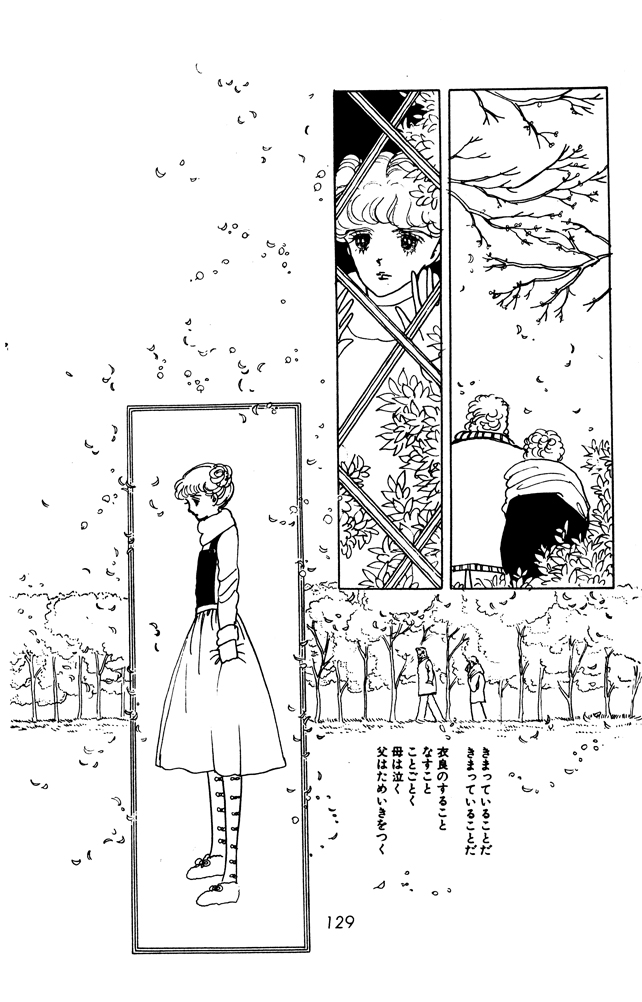
Oshima’s line is delicate, even wavery, eschewing the popular “paste jewelry†gleam of seventies’ shojo for a soft, ethereal surface. With an innovative use of white space, her deceptively quiet page designs often have a slightly eccentric, off-kilter quality. (Figs. 06.13, 06.14)
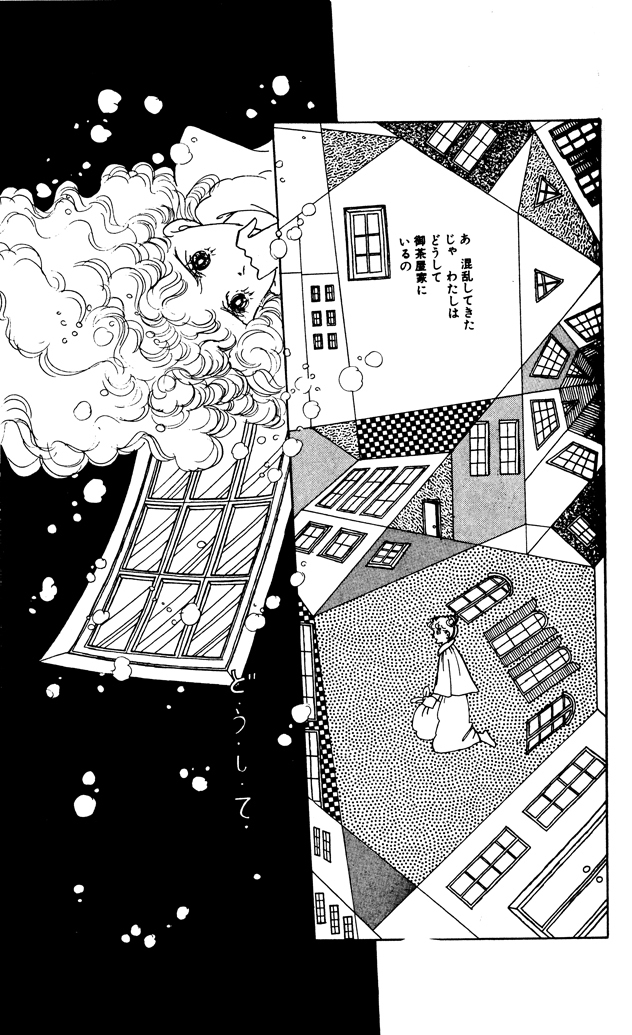
Oshima’s protagonists are off-kilter as well; gentle outsiders, precariously walking the border between the everyday and their own world of imagination, dreams and magic. Ira, the heroine of Banana Bread Pudding, is a fragile, neurotic young woman, terrorized by visions of a beautiful, androgynous demon, and traumatized by the upcoming marriage of her idolized older sister who protects her from her nightmares by singing to her at night. Ira confides in her friend Saeko that she could only marry a closeted gay man, for whom she could act as “cover.â€Â Saeko recruits her handsome, playboy brother to play the part by pretending to be gay. Banana Bread Pudding functions on one level as romantic comedy, but ultimately the story confounds any genre expectations, taking us through much darker places. Even Oshima’s popular children’s series, Wata No Kunihoshi[HS4] (Star of Cottonland), about a kitten who believes she will become human, has its traumatic and somber moments. (Fig. 06.15)
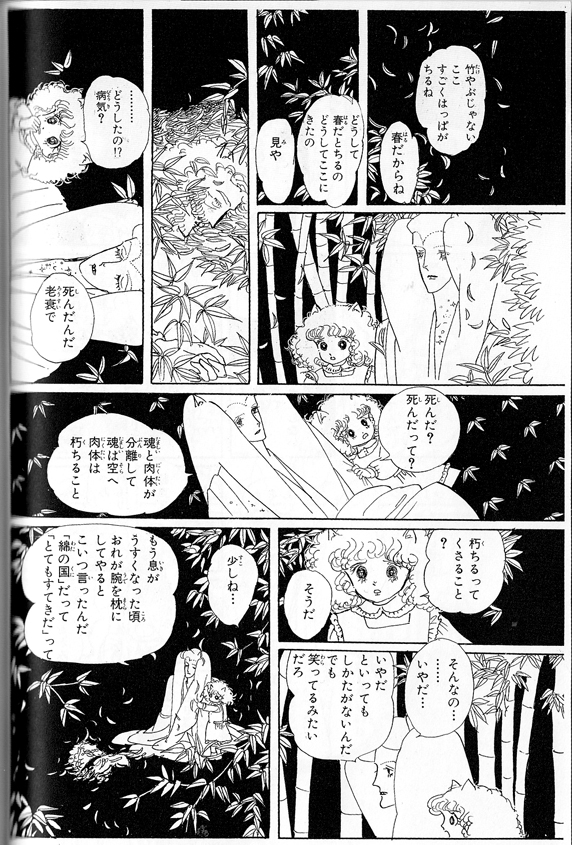
Little known in the west (as of 2012 none of her work has been translated), Oshima has been highly influential in Japan: her gentle characterization and light touch were emulated by many younger artists who took part in the diversification from shojo into josei (“ladies’â€) comics, in the coming decade.
